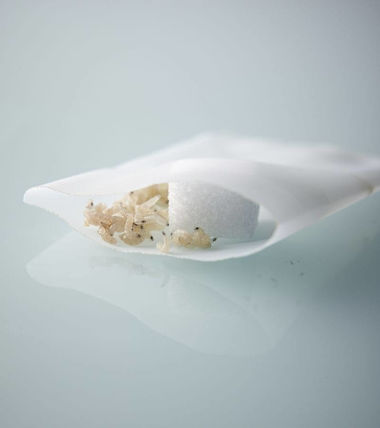Larvae as Mini-Surgeons Support Wound Healing

August 2017
The Department of Dermatology offers larva therapy to relieve wounds of dead tissue. This acts more efficiently and less painfully than surgical interventions for chronic, open wounds.
A kind of large "tea bag" holds the contents: It contains 50-300 gold fly larvae (Lucilia sericata), a type of fly that eats only dead tissue. Placed into a chronic open wound, the larvae provide a fine network of secretions that liquefies dead tissue. It is then absorbed by the larvae. Dr. Mona Bidier, specialist at the Department of Dermatology at Heidelberg University Hospital, sees several advantages to this method. “The procedure is less painful than a surgical intervention - and it is particularly suitable for wounds that have been colonized by multi-resistant organisms, since the digestive secretions of the larvae reduce the bacterial load. “The only drawback to this treatment option: "You have to be patient. It takes about four to twelve days to see significant improvements."
Fly Larvae -Specialists for Poorly Healing Wounds
The orderly process of wound healing is impaired in chronic wounds. In order to cure wounds of patients e.g. with pressure ulcers (decubiti), open leg (venous insufficiency), or also diabetic foot, and to prevent infection of the surrounding tissues, infected or dead tissue must be removed. The quickest way is surgical debridement, which is painful and successful only when there is sufficient tissue perfusion. In difficult cases, the fly larvae can jump in - with their digestive secretions - and thus, provide treatment at tricky locations with less need for pain medications and antibiotics.
For patients, larval therapy takes some getting used to - and they have the same two fears: Does it hurt? And: Can the larvae reproduce in the wound? "It can tingle a bit," says Dr. Mona Bidier, which is why patients can request an additional pain reliever. The larvae cannot reproduce, because to do so they would need to develop into adult flies. After a maximum of four days, the larvae are up to 12 mm in size and a treatment cycle is considered finished. The little helpers are replaced as needed with a bag of new, hungry replacements. - There is insufficient time for the pupal stage or any reproduction.
Forgotten Helpers from Napoleonic Times
Larva therapy is not a new invention. Already in the time of Napoleon there were reports of a surgeon who had observed that soldiers had a better chance of survival, after lying for a longer time on the battlefield after being wounded - if the larvae of the "blue fly" had colonized the wound and begun their helpful work. Today, there are numerous scientific publications documenting the effectiveness of fly larvae. The great increase in multi-resistant bacteria is one reason that these supposed "vermin" are welcome and gentle assistants in the care of stubborn, painful wounds.

